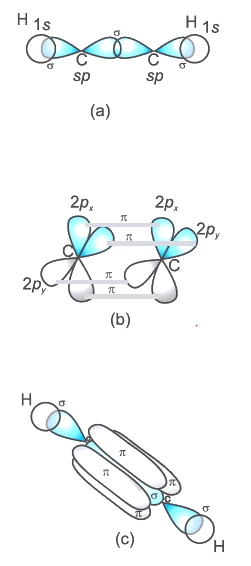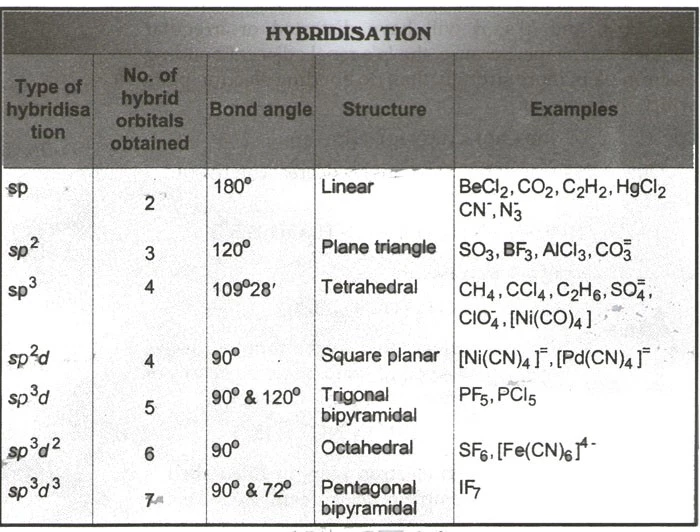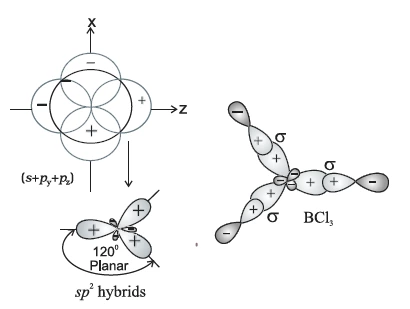Hybridisation
What is Hybridization? Definition, Characteristics & Types
Pauling (1931) proposed the revolutionary concept of hybridisation. The redistribution of the energies of the atomic orbitals of individual atoms to give new orbitals of equivalent energy is called hybridisation.
What is Hybridisation?
Definition of Hybridisation: The process of intermixing of atomic orbitals of nearly the same energies to form a new set of orbitals having equivalent energies is called Hybridisation. The orbitals thus formed are called hybrid orbitals.

Conditions of Hybridisation
(i) Orbitals of a central atom only would undergo hybridisation.
(ii) The orbitals of almost the same energy level can be mixed to form hybrid orbitals.
(iii) The numbers of atomic orbitals mixed together are always equal to the number of hybrid orbitals.
(iv) During hybridisation, the mixing of the number of orbitals is as per requirement.
(v) The hybrid orbitals are distributed in space and tend to the farthest apart.
(vi) Hybrid bonds are stronger than the non-hybridised bonds.
(vii) If an orbital has been used to form a hybrid orbital, it is no longer available to hold electrons in its ‘pure’ form.
Characteristics of Hybridisation
- The number of hybrid atomic orbitals is equal to the number of atomic orbitals involved in Hybridisation.
- The hybrid orbitals are always equal in shape and energy.
- The hybrid orbitals form a more stable bond than the pure atom orbital.
- Atomic orbitals belonging to the same atom or ion having similar energies get hybridized.
- The hybrid orbitals are more effective in creating bonds as compared to pure atomic orbitals.
- The hybrid orbitals are directed towards specific directions in space to have some stable arrangement and giving suitable geometry to the molecule.
- The type of hybridisation gives us the shape of the molecule.
Types of Hybridisation
spHybridisation
When 1s orbital and 1p orbital hybridize to give two hybridisation orbitals, the hybridisation state is sp.
Example: C2H2

It can be understood with the below steps
1) Both the carbon atoms undergo sp-Hybridisation having two unhybridized orbitals, i.e., 2py and 2px.
2) One sp hybrid orbital of a carbon atom overlaps axially with sp hybrid orbital of another carbon atom to form a C-C sigma bond, while the other hybridized orbital of each carbon atom overlaps axially with the half-filled orbital of hydrogen atoms making sigma bonds.
3) Each of the two unhybridized p orbitals of both the carbon atoms overlaps sidewise to form two pie bonds between the carbon atoms.
4) Therefore, the triple bond between the two carbon atoms is made up of one sigma and two pi bonds

sp2Hybridisation
When 1s and 2p orbital hybridize to form three hybrid orbitals, the hybridisation state is sp2.
Example: BCl3
The ground state electronic configuration of the central boron atom is
1s2 , 2s2 , 2p1.
In the excited state, one of the electrons from 2s orbital is promoted to vacant 2p orbital as (s +py + pz)

sp3 Hybridisation
When 1 s and 3p orbitals hybridize to form four hybrid orbitals, the hybridisation state is sp3.
Example: CH4
The ground state electronic configuration of central Carbon atom is 2s2, 2p2.
In the excited state, one of the 2s electrons is promoted to vacant 2p orbital as (s,+px +py + pz)

Determination of the total number of Hybrid Orbitals
- Identify the central atom along with the peripheral atoms.
- Count the electrons in the valence shell of the central atom and the peripheral atoms.
- Note the above value and divide it by 8. Then the quotient gives the number of s bonds and the remainder gives the non-bonded electrons.
So, the number of lone pair = non-bonded electrons
2
- The number of s bonds and the lone pair determines the total number of hybrid orbitals.
For example -SF4- Central atom S; Peripheral atom -F

Number of valence electrons = 6 + (4 × 7) = 34
Then, 34/8 = 4 2/8
∴ Number of hybrid orbitals = 4 sigmas (σ) bonds + 1 lone pair
Thus, five hybrid orbitals are necessary, and hybridisation state is sp3d.

Example: C2H2

2) One sp hybrid orbital of a carbon atom overlaps axially with sp hybrid orbital of another carbon atom to form a C-C sigma bond, while the other hybridized orbital of each carbon atom overlaps axially with the half-filled orbital of hydrogen atoms making sigma bonds.
3) Each of the two unhybridized p orbitals of both the carbon atoms overlaps sidewise to form two pie bonds between the carbon atoms.
4) Therefore, the triple bond between the two carbon atoms is made up of one sigma and two pi bonds

Example: BCl3
The ground state electronic configuration of the central boron atom is
1s2 , 2s2 , 2p1.
In the excited state, one of the electrons from 2s orbital is promoted to vacant 2p orbital as (s +py + pz)

Example: CH4
The ground state electronic configuration of central Carbon atom is 2s2, 2p2.
In the excited state, one of the 2s electrons is promoted to vacant 2p orbital as (s,+px +py + pz)




